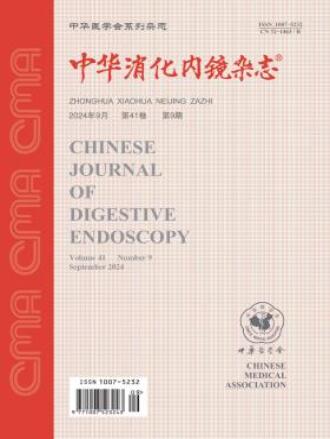Clinical value of repeated peroral endoscopic myotomy for persistent/recurrent achalasia
引用次数: 0
Abstract
Objective To evaluate the feasibility, safety and efficacy of repeated peroral endoscopic myotomy (Re-POEM) as a make-up therapy after POEM failure. Methods Thirty-three patients with persistent/recurrent symptoms after first POEM (Eckardt symptom score≥4) were selected from a database of a total of 2 516 consecutive patients with achalasia. The main outcome measures was Eckardt score during follow-up; the secondary outcome measures were procedure-related adverse events, changes in manometric lower esophageal sphincter (LES) pressure, and reflux symptoms before and after Re-POEM. Results All patients successfully underwent Re-POEM in mean 18.6 months (ranging 3-55 months) after their first POEM procedures. The mean symptom score before Re-POEM was 5.5 (ranging 4-8). Mean operation time was 45.1 minutes (ranging 28-64 minutes). Submucosal tunnel infection occurred in 1 patient who recovered with conservative treatment. During a mean follow-up period of 36.6 months (ranging 12-58 months), symptom relief was achieved in all patients. Eckardt score reduced to 1.3 (ranging 0-3), significantly different from that before (P<0.001). Mean LES pressure also declined from 26.0 mmHg (1 mmHg=0.133 kPa) to 9.6 mmHg after Re-POEM (P<0.001). The incidence of gastroesophageal reflux of Re-POEM was 33.3% (11/33). Conclusions Re-POEM appears safe and effective as a make-up option after POEM failure. Key words: Esophageal achalasia; Peroral endoscopic myotomy; Repeated peroral endoscopic myotomy反复经口内镜下肌切开术治疗持续性/复发性贲门失弛缓症的临床价值
目的探讨经口反复内镜下肌切开术(Re-POEM)作为手术失败后补足治疗的可行性、安全性和有效性。方法从连续2 516例贲门失弛缓症患者数据库中选择33例首次POEM后出现持续/复发症状(Eckardt症状评分≥4)的患者。随访时主要结局指标为Eckardt评分;次要结局指标为手术相关不良事件、食管下括约肌(LES)压力的变化以及Re-POEM前后的反流症状。结果所有患者在第一次POEM术后平均18.6个月(3-55个月)成功行二次POEM。Re-POEM前的平均症状评分为5.5分(范围4-8分)。平均手术时间45.1分钟(28 ~ 64分钟)。1例患者发生粘膜下隧道感染,经保守治疗后痊愈。在平均36.6个月(12-58个月)的随访期间,所有患者的症状均得到缓解。Eckardt评分降至1.3(范围0-3),与治疗前比较差异有统计学意义(P<0.001)。Re-POEM术后平均LES压也从26.0 mmHg (1 mmHg=0.133 kPa)降至9.6 mmHg (P<0.001)。Re-POEM胃食管反流发生率为33.3%(11/33)。结论:Re-POEM作为POEM失败后的补充选择是安全有效的。关键词:食道失弛缓症;经口内窥镜肌切开术;反复经口内窥镜肌切开术
本文章由计算机程序翻译,如有差异,请以英文原文为准。
求助全文
约1分钟内获得全文
求助全文
来源期刊
CiteScore
0.10
自引率
0.00%
发文量
7555
期刊介绍:
Chinese Journal of Digestive Endoscopy is a high-level medical academic journal specializing in digestive endoscopy, which was renamed Chinese Journal of Digestive Endoscopy in August 1996 from Endoscopy.
Chinese Journal of Digestive Endoscopy mainly reports the leading scientific research results of esophagoscopy, gastroscopy, duodenoscopy, choledochoscopy, laparoscopy, colorectoscopy, small enteroscopy, sigmoidoscopy, etc. and the progress of their equipments and technologies at home and abroad, as well as the clinical diagnosis and treatment experience.
The main columns are: treatises, abstracts of treatises, clinical reports, technical exchanges, special case reports and endoscopic complications.
The target readers are digestive system diseases and digestive endoscopy workers who are engaged in medical treatment, teaching and scientific research.
Chinese Journal of Digestive Endoscopy has been indexed by ISTIC, PKU, CSAD, WPRIM.

 求助内容:
求助内容: 应助结果提醒方式:
应助结果提醒方式:


